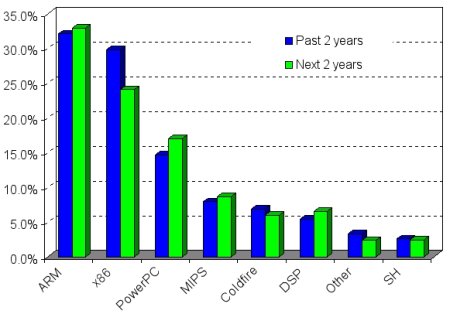Life’s sweet for PowerPC, despite sour Apple
Jun 9, 2005 — by Henry Kingman — from the LinuxDevices Archive — viewsApple may be going x86, but PowerPC is currently the fastest-growing architecture in the embedded industry, a LinuxDevices.com's 2005 reader survey suggests. That assertion is supported by the news yesterday that eleven companies have joined Power.org, a community of organizations using PPC in everything from consumer electronics devices to supercomputers.
In terms of volume shipments, it is generally agreed that the embedded industry accounts for 98 percent of all processors, compared with about two percent for the desktop and server markets. These figures were recently cited by device software specialist Wind River.
LinuxDevices.com's annual survey for 2005 suggested that PowerPC — the architecture behind Power.org — is the third most popular embedded architecture, behind ARM and x86, and the one with the highest growth rate, while x86 is shrinking rapidly.

PowerPC is the fast-growing architecture in embedded
High-profile PowerPC design wins
PowerPC is gaining users in embedded because of technical traits like mature 64-bit support, low power and cooling requirements, and fast floating-point performance. Recent high profile successes for the architecture include the multicore Cell processor, co-developed by Sony, IBM, and Toshiba, and the custom triple-core PowerPC-based processor developed by IBM for Microsoft's use in the Xbox 360 (the Xbox 360's processor boasts three symmetrical cores, each running at 3.2GHz clock rate).
Another design win of note is the multicore PowerPC SoC that powers IBM's formidable BlueGene, the world's fastest supercomputer. And, embedded chipmaker AMCC has successfully marketed a number of new PowerPC SoCs after acquiring the 400-series PowerPC cores from IBM last April — about the same time IBM announced a flexibile, Linux-like PowerPC licensing model aimed at broadening the architecture's ecosystem of third-party chip design, integration, and manufacturing service providers.
Flexible licensing
IBM announced a Linux-like licensing model for the Power architecture on April Fools Day, 2004, at a “Power Everywhere” event in New York City aimed at broadening the base of PowerPC licensees and service providers. IBM's open source Power licensing program aims to reward companies, partners, and researchers who embed Power cores in system-on-chips (SoCs) targeting a variety of applications.
Eight months after the Power Everwhere event, fifteen companies formed Power.org as a center for the architecture's third-party ecosystem to grow around. Currently, 28 companies belong to Power.org, the organization says, with 11 announcing their membership yesterday at an event at the Barcelona SuperComputer Center. The event also featured a number of previous Power.org members sharing success stories.
New Power.org members
Eleven chipmakers, design and manufacturing houses, IP (intellectual property) vendors, and contract silicon service providers announced yesterday that they have joined Power.org. New Power.org members announced yesterday include:
- AboveMicro — A startup in Shanghai providing ASIC design and subcontracting services internationally. Specialities include design optimization for low power, high performance, and low cost.
- Anyka Cayman — A fabless design house in China that designs, markets, and sells VLSI (very large-scale integration) chips for mobile multimedia handheld devices.
- Barcelona Supercomputing Center — Barcelona Supercomputing Center (BSC) joins Power.org as a formal participant in order to more effectively drive future design and standards based on Power Architecture technologies, it says.
- Celestica — A global EMS (electronics manufacturing services) provider with operations in Asia, Europe, and the Americas
- DAFCA — An EDA (electronic design automation) software company based in Framingham, Massachusetts specializing in in-silicon discovery, rapid root-cause analysis, and error fixing of sophisticated SoCs.
- Forte Design Automation — A tools provider that markets a Cynthesizer product said to provide an automated path from C-algorithms to high-performance hardware
- Rapport Incorporated — A silicon vendor specializing in configurable chips with thousands of flexibly connected parallel processors, such as the Kilocore
- Teak Technologies — A vendor of patented, standards-compliant switching technology for high-performance server/networking applications
- TimeLab — A silicon vendor specializing in highly integrated digital semiconductors meant to replace analog circuits in clocking, synchronization, and data conversion applications
- Universal Scientific Industrial — A global DMS (design and manufacturing services) company offering value-added engineering and manufacturing services for NAS (network-attached storage) and media center applications
- Venture Corporation Limited — An outsourcing services provider for elctronics companies
Power.org success stories
A number of attendees at the Barcelona Power.org event announced new products or shared success stories for existing products. These announcements included:
- Thales — Introduced the EasyG5, claimed to be the first Dual-G5 VME system on the market. VME is an older high-end bus standard for avionics and military embedded applicaitons.
- Max Planck Society — Announced it will use POWER5 processor based IBM eServer p5 575 supercomputing system in nanotechnology and environmental protection research
- Xilinx — Announced “significant momentum” for its Virtex-II Pro Platform FPGAs with integrated PowerPC cores
- Synopsys — Shipped synthesizable RTL versions of IBM's PowerPC 405 and 440 processors as part of its DesignWare Star IP (intellectual property) program
Other Power.org members include AMCC, Bull, Cadence Design Systems, Chartered Semiconductor Manufacturing, Culturecom, IBM, Jabil Circuit, Novell, Red Hat, Sony Corporation, Shanghai Belling, Synopsys, Thales, Tundra Semiconductor, and Wistron.
This article was originally published on LinuxDevices.com and has been donated to the open source community by QuinStreet Inc. Please visit LinuxToday.com for up-to-date news and articles about Linux and open source.